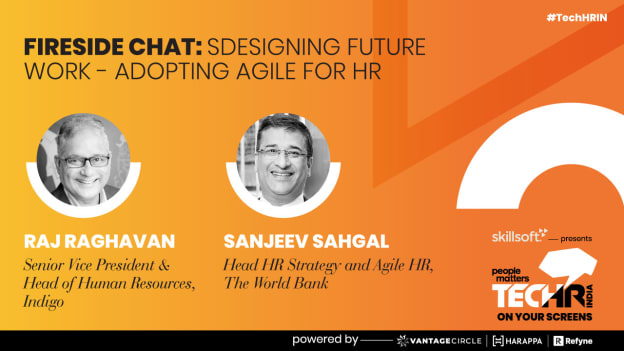Designing future work - Adopting Agile for HR

The evolution of the software industry from waterfall model to agile now is now being adopted in other business functions as well. The word ‘agile’ isn't just used for tech anymore; it is growing as a philosophy sweeping other functions including Human Resources in many industries globally. Leaders in HR are hoping to design future work by adopting agile as a philosophy, a culture and a set of management practices to transform how organizations plan to acquire, manage and develop their human assets.
With the future of work bringing more unpredictability, it is clear that people practices cannot be inflexible. Hence, redesigning future work by adopting the agile methodologies in many ways will become the base to take HR practices to the next higher level. In a fireside chat at People Matters TechHR 2021, Sanjeev Sahgal - Head HR Strategy and Agile HR at The World Bank and Raj Raghavan, Senior Vice President & Head of Human Resources at Indigo shed light on the same.
So, what does agile mean for the HR function?
With complex people management challenges like developing future leaders for roles that does not even exist yet or creating a measurable personalized employee experience (EX) instantaneously, HR Leaders somehow are left with no choice but to go ahead with immediate big bang solutions like deploying leadership development program with premium institutes or introducing immediate tech solutions to enhance EX as a reactive approach to solve such challenges. With agile principle in HR, such complex HR issues can be broken down into value driven achievable slices answering what’s and why’s of the business in a proactive way.
Agile in HR brings an iterative approach of developing strategies, interventions and initiatives that are more structured and involve experimentation, integration, and constant review coupled with a collaborative culture. Though agile has sprung from the software development domain, yet the principles of agile are increasingly tried out in the world of other domains, HR being one of them. Agile HR model helps to create responsive management practices that include frequent feedback loops, engaging teams in short work cycles and frequent retrospectives resulting in a much more proactive approach rather than a reactive one.
Agile HR helps leaders to manage volatility with enhanced adaptability in HR processes and strategies. By applying agile methodologies to talent management processes, Agile for HR has brought in the potential to re-invent and strengthen the entire human resource function. Raj Raghavan, Senior Vice President & Head of Human Resources at Indigo clearly advocates that Agile HR model can definitely help to ‘drive programs that create adaptability, innovation and collaboration’ much faster than the ‘traditional HR practices that focuses primarily on rules and standards with a strict hierarchical structure’.
What are the best practices for adopting agile innovation approach in HR?
Sanjeev Sahgal - Head HR Strategy and Agile HR at The World Bank having presence in about 130 countries have adopted agile HR to solve talent related challenges moving from ‘policy based approach’ to ‘principle based approach’ for a much better employee experience. He states that ‘as an HR in the organization, we need to ensure that there is collaboration to meet rapidly changing employee and clients expectations’. By infusing agile philosophies, it is now more about ‘how do you really make rapid decisions and how do you ensure accountability is given at the lowest level where action is actually taken’.
Raj Raghavan builds on further stating that HR could bring in a great impact by ‘using an agile mindset’. It is about truly stepping out of the old tradition of following HR practice and embracing a test and learn approach to deliver value; that can be validated by ‘our people’ and their ‘experience of work’. HR leaders need to embrace this mindset to successfully adopt agile tools and practices within teams and projects.
Current and future outlook of agile HR
As organizational structures are seen becoming more fluid, the static frameworks of HR practices are not able to meet the requirements of a value driven HR function. Also, the readiness of organizations to adopt a new set of principles and behaviors in support of agile is yet to mature. Many organizations are still stuck with heavy compliance driven, bureaucratic and silo based HR processes continuing with the legacy of top-down decision making.
Hence, it is time to adopt a way of working that facilitates responsiveness and adaptiveness in HR structures and processes. Moving beyond the limiting and restricted viewpoint of HR to just implementing controls and standards for driving execution, leaders must use agile principles to help bring real change by facilitating programs and strategies for improving organizational agility, improved decision making and innovation.












